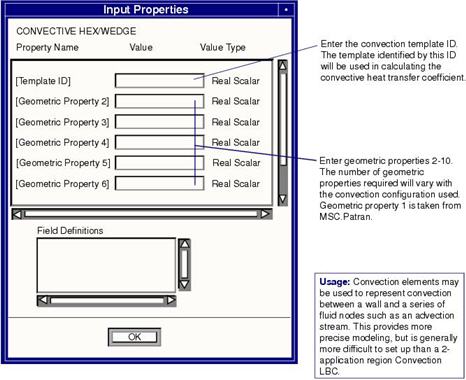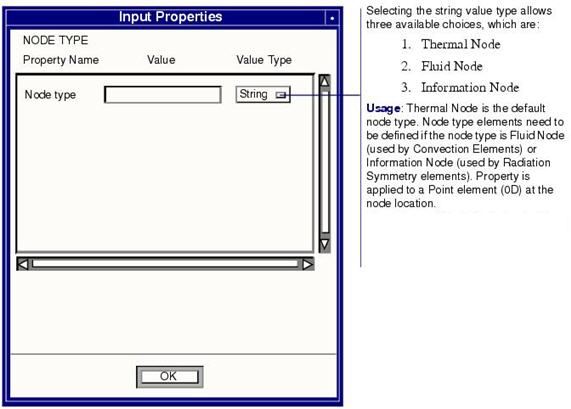
Analysis Type | Dimension | Type | Option(s) | Topologies |
Thermal | 0D | Node type | none | Point |
Note: | This 0D element replaces the functionality of type “F” and “I” nodes in PATRAN 2.5. |

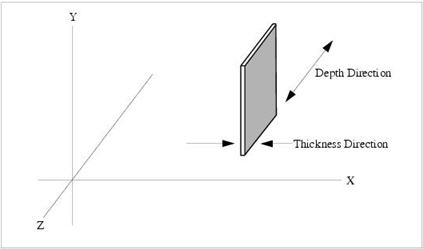
Analysis Type | Dimension | Type | Option(s) | Topologies |
Thermal | 1D | Conduction Bar | Bar with capacitance Bar without capacitance Scaled Bar Element 3D Conduction Bar Scaled 3D Conduction Bar Conductor | Bar/2 |
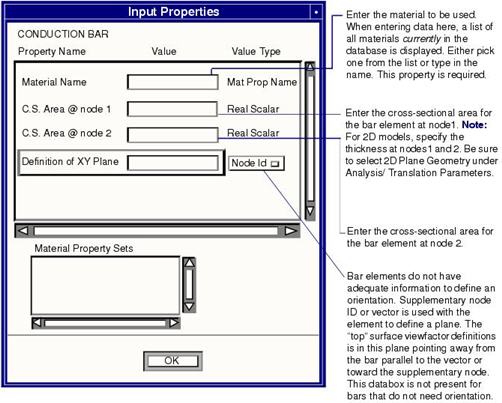
Note: | Advection moves energy from one node to another and quasi steady state is implicit in this formulation. If transient analysis is to be performed, conduction bars need to be assigned parallel to the advection bars so the internal energy in each fluid node is properly modelled. |
Analysis Type | Dimension | Type | Option(s) | Topologies |
Thermal | 1D | Advection Bar | none | Bar/2 |
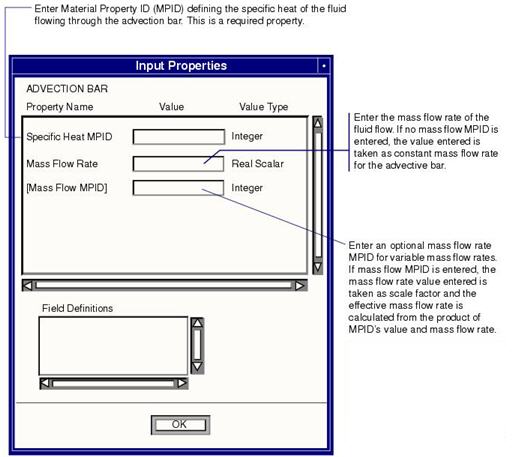
Note: | The MPID is an integer number referring to a user-defined MPID in the mat.dat file or to a Material Property/General Fields, 43 with this MPID number in the Input Data Form. |
Analysis Type | Dimension | Type | Option(s) | Topologies |
Thermal | 1D | Flow network bar | Flow network pipe/ Constant property pipe Constant property pipe with moody curve Variable property pipe | Bar/2 |
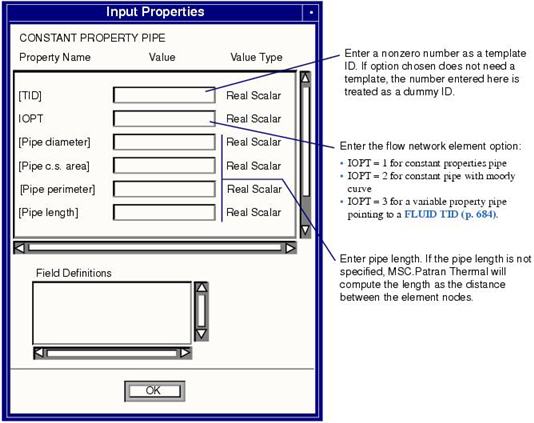
Property Name | Option Description | ||
Constant Property | with Moody Curve | Variable Property | |
[TID] | Supply a non-zero dummy TID value. | Pointer to FLUID Template ID in template.dat. | |
IOPT | Enter a 1. | Enter a 2. | Enter a 3. |
[Pipe diameter] | Hydraulic diameter of the flow passage defined as 4*CSArea/wetted perimeter. (For a circular cross section, hydraulic diameter=physical diameter). If diameter is not specified, it will be calculated using the cross-sectional area and wetted perimeter specified below. | ||
[Pipe c.s. area] | Cross-section area of the flow passage. If not specified it will be calculated assuming a circular cross section and specified diameter. | ||
[Pipe perimeter] | Wetted perimeter of the flow passage. If it is not specified, it is calculated assuming a circular cross section. | ||
[Pipe length] | The length of the bar element. If it is not specified, it will be calculated as the straight line distance between the end nodes of the bar element. | ||
[Pipe roughness] | Surface roughness of the tube or the flow passage. | ||
[Head loss coeff] | Head loss coefficient to account for minor losses in the flow network, e.g., losses in bends, tees, valves, sudden expansion/contractions, etc. | A scale factor to the MPID_LOSS_COEF material property in the FLUID Template. | |
[Fluid density] [Fluid viscosity] [Specific Heat] | Specific weight (F/L3), dynamic viscosity (M/LT) and specific heat of the fluid flowing through the network. Must be consistent with the units that are used to solve the thermal problem. If applicable to the system of units, Patran Thermal will convert specific weight to mass-density based on the ICCALC flag. | Fluid density (MPID_RHO), viscosity (MPID_MU) and specific heat (MPID_CP) are defined in the FLUID template.* | |
[Friction factor]* | Friction factor used to calculate the head loss due to flow. | [not present for this option]. Patran Thermal will compute the friction factor from Moody’s chart. | Scale factor to the MPID_F material property defined in the FLUID template. Note: A zero MPID_F activates the Moody equation. |
[Coeff thermal expansion] | Coefficient of thermal expansion used in calculation of buoyancy head. note: Gravitational constant and direction is specified under Hydraulic Run Control Parameters. | Thermal expansion coefficient is defined with an MPID_BETA material property in FLUID template. * | |
* a dummy value must be entered for these parameters. | |||
FLUID | TID | #MPID's | IOPT |
MPID_RHO | MPID_MU | MPID_CP | |
MPID_LOSS_COEFF | MPID_BETA | MPID_F |
FLUID | Template record type. |
TID | User template ID. A nonzero value which couples the Element Property record to the information referenced in the template file. |
MPID_RHO | Material property ID which references the specific weight of the fluid flowing through the flow network (units of F/L3). Specific weight must be consistent with the units that are used to solve the thermal problem. If applicable to the system of units, Patran Thermal will convert specific weight to mass-density based on the ICCALC flag. |
MPID_MU | Material property ID which references the dynamic viscosity of the fluid flowing through the network (units = M/LT). |
MPID_CP | Material property ID which references the specific heat of the fluid flowing through the network. |
MPID_LOSS_COEFF | Material property ID which defines a variable Head Loss Coefficient |
MPID_BETA | Material property ID which references the coefficient of thermal expansion used in calculating the buoyancy head (g * HBETA * DT). |
MPID_F | Material property ID which references the friction factor used to calculate the head loss due to flow in a tube. If not specified, friction factor is calculated with Moody's equation. |
Analysis Type | Dimension | Type | Option(s) | Topologies |
Thermal | 1D | Flow network bar | Turbine element | Bar/2 |
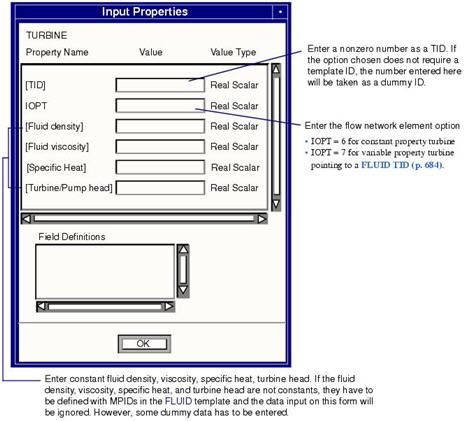
Property Name | Option Description | ||
Constant Property | Variable Property | ||
[TID] | Supply a non-zero dummy TID value. | Pointer to FLUID Template ID in template.dat. | |
IOPT | Enter a 6. | Enter a 7. | |
[Fluid density] [Fluid viscosity] [Specific Heat] | Specific weight (F/L3), dynamic viscosity (M/LT) and specific heat of the fluid flowing through the network. Must be consistent with the units that are used to solve the thermal problem. If applicable to the system of units, Patran Thermal will convert specific weight to mass-density based on the ICCALC flag. | Fluid density (MPID_RHO), viscosity (MPID_MU) and specific heat (MPID_CP) are defined in the FLUID template. A dummy value must be entered on the form. | |
[Turbine head] | Constant turbine head, cannot go positive. | Turbine head is defined with an MPID_HEAD material property in the FLUID template. The independent variable for head can be time or flowrate. A dummy value must be entered on this form. Note: For head vs flowrate, select the independent variable ITSCALE in the MPID as “temperature” in the same units as solution temperature units, ICCALC flag. | |
FLUID | TID | #MPID's | IOPT |
MPID_RHO | MPID_MU | MPID_CP | |
MPID_HEAD |
FLUID | Template record type. |
TID | User template ID. A nonzero value which couples the Element Property record to the information referenced in the template file. |
MPID_RHO | Material property ID which references the specific weight of the fluid flowing through the flow network (units of F/L3). Specific weight must be consistent with the units that are used to solve the thermal problem. If applicable to the system of units, Patran Thermal will convert specific weight to mass-density based on the ICCALC flag. |
MPID_MU | Material property ID which references the dynamic viscosity of the fluid flowing through the network (units = M/LT). |
MPID_CP | Material property ID which references the specific heat of the fluid flowing through the network. |
MPID_HEAD | Turbine head as function of time or flow rate. Note: Turbine head can be a function of time or flow rate. For independent variable of flow rate, build the MPID as if it were “temperature” dependent in the same ITSCAL units as the solution temperature units, ICCALC. |
Analysis Type | Dimension | Type | Option(s) | Topologies |
Thermal | 1D | Flow network bar | Pump element | Bar/2 |
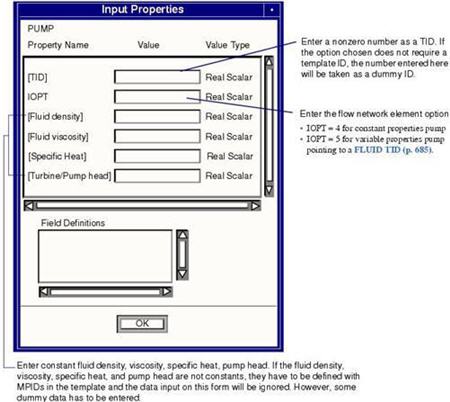
Property Name | Option Description | |
Constant Property | Variable Property | |
[TID] | Supply a non-zero dummy TID value. | Pointer to FLUID Template ID in template.dat. |
IOPT | Enter a 4.+ | Enter a 5. |
[Fluid density] [Fluid viscosity] [Specific Heat] | Specific weight (F/L3), dynamic viscosity (M/LT) and specific heat of the fluid flowing through the network. Must be consistent with the units that are used to solve the thermal problem. If applicable to the system of units, Patran Thermal will convert specific weight to mass-density based on the ICCALC flag. | Fluid density (MPID_RHO), viscosity (MPID_MU) and specific heat (MPID_CP) are defined in the FLUID template. A dummy value must be entered on the form. |
[Turbine head] | Constant pump head, cannot go negative. | Pump head is defined with an MPID_HEAD material property in the FLUID template. The independent variable for head can be time or flowrate. A dummy value must be entered on this form. Note: For head vs flowrate, select the independent variable ITSCALE in the MPID as “temperature” in the same units as solution temperature units, ICCALC flag. |
FLUID | TID | MPID's | IOPT |
MPID_RHO | MPID_MU | MPID_CP | |
MPID_HEAD |
FLUID | Template record type. |
TID | User template ID. A nonzero value which couples the Element Property record to the information referenced in the template file. |
MPID_RHO | Material property ID which references the specific weight of the fluid flowing through the flow network (units of F/L3). Specific weight must be consistent with the units that are used to solve the thermal problem. If applicable to the system of units, Patran Thermal will convert specific weight to mass-density based on the ICCALC flag. |
MPID_MU | Material property ID which references the dynamic viscosity of the fluid flowing through the network (units = M/LT). |
MPID_CP | Material property ID which references the specific heat of the fluid flowing through the network. |
MPID_HEAD | Pump head as function of time or flow rate. Note: Pump head can be a function of time or flow rate. For independent variable of flow rate, build the MPID as if it were “temperature” dependent in the same ITSCAL units as the solution temperature units, ICCALC. |
Analysis Type | Dimension | Type | Option(s) | Topologies |
Thermal | 1D | Flow network bar | Check Valve element | Bar/2 |
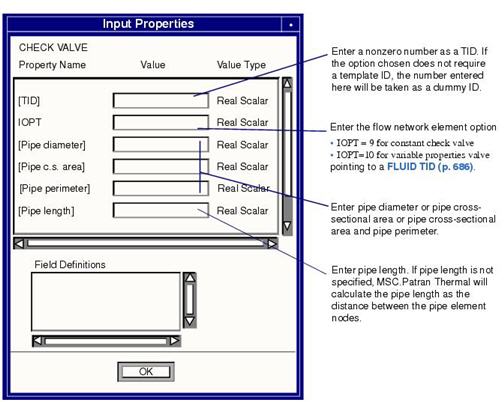
Property Name | Description |
[Pipe roughness] | Enter pipe roughness. |
[Head loss coeff] | Enter the head loss coefficient. This can represent head loss in pipe bends, valves, fittings, etc. |
[Fluid density] [Fluid viscosity] [Specific Heat] | Enter the constant fluid density, viscosity, specific head. If the fluid density or viscosity or specific heat are not constants, they have to be defined with MPIDs in the template and the data input on this form is ignored. However, some dummy data has to be entered. |
[Coeff thermal expansion] | Enter coefficient of thermal expansion. |
TID | A dummy ID, not used by Patran Thermal flow network. Supply a nonzero dummy TID. No template record required. |
IOPT | The option chosen for the flow bar element. IOPT = 9. |
DIAM | A hydraulic diameter of the flow passage defined as 4 * CSArea / wetted perimeter. (For a circular cross section hydraulic diameter = physical diameter.) If diameter is not specified, it will be calculated using the cross sectional area and wetted perimeter. |
CSAA | Cross sectional area of the flow passage. If it is not specified, it will be calculated assuming a circular cross sectional and specified diameter. |
PERIM | Wetted perimeter of the flow passage. If it is not specified, it is calculated assuming a circular cross section. |
LENGTH | The length of the bar element. If it is not specified, it will be calculated as the straight line distance between the end nodes of the bar element. |
ROUGHNESS | Surface roughness of the tube or the flow passage. |
LOSS_COEFF | Head loss coefficient to account for minor losses in the flow network, e.g. losses in bends, tees, values, sudden expansion/contraction, etc. |
DENSITY | The specific weight of the fluid flowing through the flow network (units of F/L3). Specific weight must be consistent with the units that are used to solve the thermal problem. If applicable to the system of units, Patran Thermal will convert specific weight to mass-density based on the ICCALC flag. |
VISCOSITY | Dynamic viscosity of the fluid flowing through the network (units = M/LT). |
SPECIFIC_HEAT | Specific heat of the fluid flowing through the network. |
HBETA | Is the coefficient of THERMAL expansion used in calculation of buoyancy head (g * HBETA * DT). |
TID | User template ID. A nonzero value which couples the PFEG record to the information referenced in the template file. |
IOPT | The option chosen for the flow bar element. IOPT = 10. |
DIAM | A hydraulic diameter of the flow passage defined as 4 * CSArea / wetted perimeter. (For a circular cross section hydraulic diameter = physical diameter.) If diameter is not specified, it will be calculated using the cross sectional area and wetted perimeter. |
CSAA | Cross sectional area of the flow passage. If it is not specified, it will be calculated assuming a circular cross sectional and specified diameter. |
PERIM | Wetted perimeter of the flow passage. If it is not specified, it is calculated assuming a circular cross section. |
LENGTH | The length of the bar element. If it is not specified, it will be calculated as the straight line distance between the end nodes of the bar element. |
ROUGHNESS | Surface roughness of the tube or the flow passage. |
LOSS_COEFF | Head loss coefficient to account for minor losses in the flow network, e.g., losses in bends, tees, values, sudden expansion/contraction, etc. This loss coefficient becomes a scale factor and is used as a multiplier to the value return from the MPID_LOSS_COEFF material property. |
FLUID | TID | MPID's | IOPT |
MPID_RHO | MPID_MU | MPID_CP | |
MPID_LOSS_COEFF | MPID_BETA | MPID_F |
FLUID | Template record type. |
TID | User template ID. A nonzero value which couples the Element Property record to the information referenced in the template file. |
MPID_RHO | Material property ID which references the specific weight of the fluid flowing through the flow network (units of F/L3). Specific weight must be consistent with the units that are used to solve the thermal problem. If applicable to the system of units, Patran Thermal will convert specific weight to mass-density based on the ICCALC flag. |
MPID_MU | Material property ID which references the dynamic viscosity of the fluid flowing through the network (units = M/LT). |
MPID_CP | Material property ID which references the specific heat of the fluid flowing through the network. |
MPID_BETA | Material property ID which references the coefficient of THERMAL expansion used in calculating the buoyancy head (g * HBETA * DT). |
MPID_F | Material property ID which references the friction factor used to calculate the head loss due to flow in a tube. If a MPID_F is not specified, the friction factor is calculated using Patran Thermal's Moody equation. |
Analysis Type | Dimension | Type | Option(s) | Topologies |
Thermal | 1D | Flow network bar | Head loss element | Bar/2 |
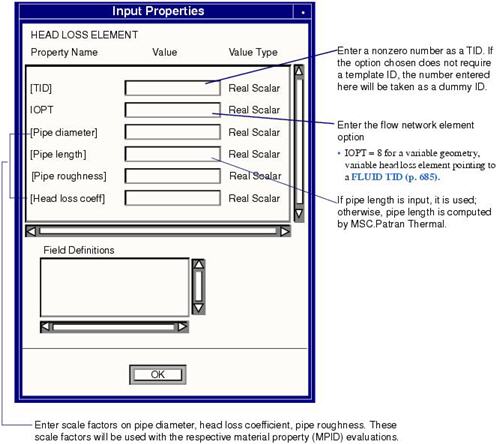
TID | User template ID. A nonzero value which couples the Element Property record to the information referenced in the template file. |
IOPT | The option chosen for the flow bar element. IOPT = 8. |
DIAM | A hydraulic diameter of the flow passage defined as 4 * CSArea / wetted perimeter. (For a circular cross section hydraulic diameter = physical diameter.) If diameter is not specified, it will be calculated using the cross sectional area and wetted perimeter. |
LENGTH | The length of the bar element. If it is not specified, it will be calculated as the straight line distance between the end nodes of the bar element. |
ROUGHNESS | Surface roughness of the tube or the flow passage. |
LOSS_COEFF | Head loss coefficient to account for minor losses in the flow network, e.g. losses in bends, tees, values, sudden expansion/contraction, etc. This loss coefficient becomes a scale factor and is used as a multiplier to the value returned from the MPID_LOSS_COEFF material property. |
FLUID | TID | #MPID's | IOPT | |
MPID_DIAM | ||||
MPID_RHO | MPID_MU | MPID_CP | ||
MPID_EPS | MPID_LOSS_COEFF | MPID_BETA | MPID_F |
FLUID | Template record type. |
TID | User template ID. A nonzero value which couples the Element Property record to the information referenced in the template file. |
MPID_DIAM | Material property ID which defines a diameter. This can be used to define variable geometry as a function of time or temperature. |
MPID_RHO | Material property ID which references the specific weight of the fluid flowing through the flow network (units of F/L3). Specific weight is consistent with the units that are used to solve the thermal problem. If applicable to the system of units, Patran Thermal will convert specific weight to mass-density based on the ICCALC flag. |
MPID_MU | Material property ID which references the dynamic viscosity of the fluid flowing through the network (units = M/LT). |
MPID_CP | Material property ID which references the specific heat of the fluid flowing through the network. |
MPID_EPS | Material property ID which references the tubing roughness. |
MPID_LOSS_COEF | Material property ID which references the loss coefficient. Could be used to model the change in loss coefficient of a global valve which has different openings as a function of time. |
MPID_BETA | Material property ID which references the coefficient of thermal expansion used in calculating the buoyancy head (g * HBETA * DT). |
MPID_F | Material property ID which references the friction factor used to calculate the head loss due to flow in a tube. |
Analysis Type | Dimension | Type | Option(s) | Topologies |
Thermal | 1D | Flow network bar | Plenum element | Bar/2 |
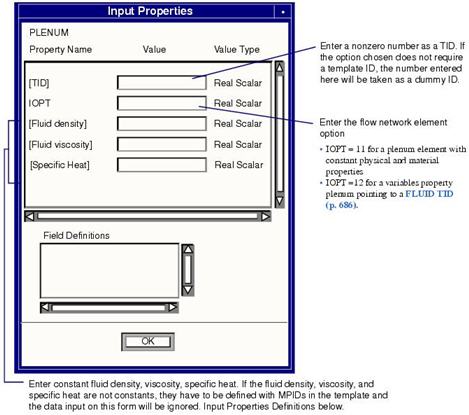
TID | A dummy ID, not used by Patran Thermal flow network. Supply a nonzero dummy TID. No template record required. |
IOPT | The option chosen for the flow bar element. IOPT = 11. |
DENSITY | The specific weight of the fluid flowing through the flow network (units of F/L3). Specific weight must be consistent with the units that are used to solve the thermal problem. *Hydraulic networks prefer a mass density and the units conversion is performed internally based on the ICCALC flag. |
VISCOSITY | Dynamic viscosity of the fluid flowing through the network (units = M/LT). |
SPECIFIC_HEAT | Specific heat of the fluid flowing through the network. |
TID | User template ID. A nonzero value which couples the PFEG record to the information referenced in the template file. |
IOPT | The option chosen for the flow bar element. IOPT=12. |
FLUID | TID | #MPID's | IOPT |
MPID_RHO | MPID_MU | MPID_CP |
FLUID | Template record type. |
TID | User template ID. A nonzero value which couples the Element Property record to the information referenced in the template file. |
MPID_RHO | Material property ID which references the specific weight of the fluid flowing through the flow network (units of F/L3). Specific weight must be consistent with the units that are used to solve the thermal problem. If applicable to the system of units, Patran Thermal will convert specific weight to mass-density based on the ICCALC flag. |
MPID_MU | Material property ID which references the dynamic viscosity of the fluid flowing through the network (units = M/LT). |
MPID_CP | Material property ID which references the specific heat of the fluid flowing through the network. |
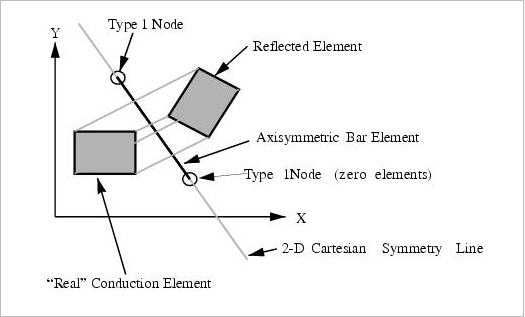
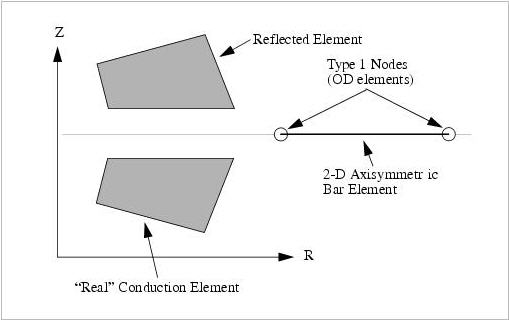
Note: | For R-Z problems, radiation symmetry bars must be parallel to the R Axis. |
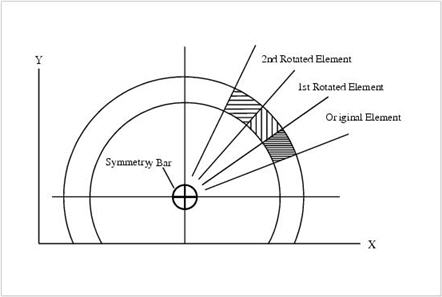
Analysis Type | Dimension | Type | Option(s) | Topologies |
Thermal | 1D | Radiation symmetry bar rotation | None | Bar/2 |

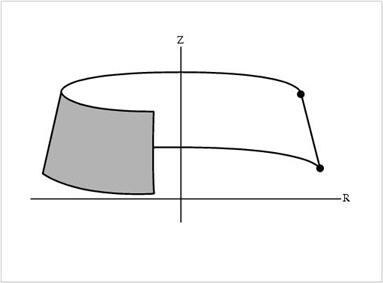
Analysis Type | Dimension | Type | Option(s) | Topologies |
Thermal | 1D | Axisymmetric Bar | Full 360 Deg Rotation Specified Deg of Rotation | Bar/2 |
Note: | This element property definition requires setting model dimensionality to axisymmetric geometry and selecting the radial and centerline axes under the Analysis, Translation Parameters. |
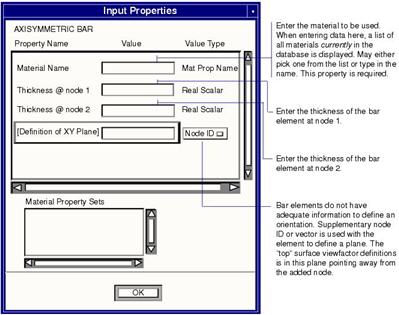
Analysis Type | Dimension | Type | Option(s) | Topologies |
Thermal | 1D | Thermal 2D Bar | Bar/2 |
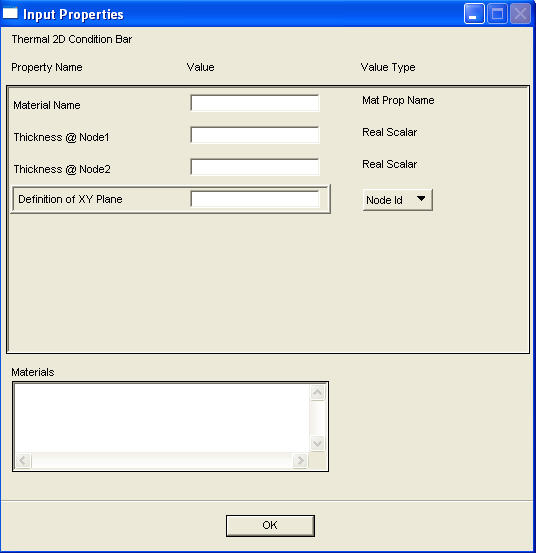
Material Name | Enter the material to be used. When entering data here, a list of all materials currently in the database is displayed. You can either pick one from the list or type in the name. This property is required. |
Thickness @Node 1 | Enter the thickness of the bar element at Node 1. |
Thickness @Node 2 | Enter the thickness of the bar element at Node 2. |
Definition of XY Plane | Node ID line as weights vector which defines the orientations of the bar element. Global orgin is the default. |
Analysis Type | Dimension | Type | Option(s) | Topologies |
Thermal | 2D | Shell | Shell Scaled Shell Element | Quad/4, Tri/3 |
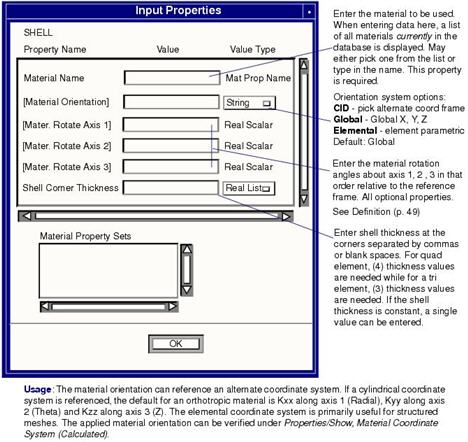
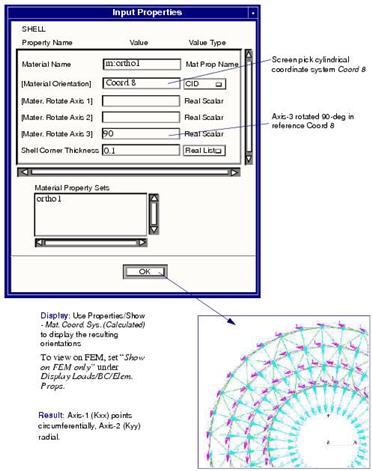

Analysis Type | Dimension | Type | Option(s) | Topologies |
Thermal | 2D | Thermal 2D | None | Quad/4, Tri/3 |
Important: | This element property definition requires setting model dimensionality to 2D Plane. |
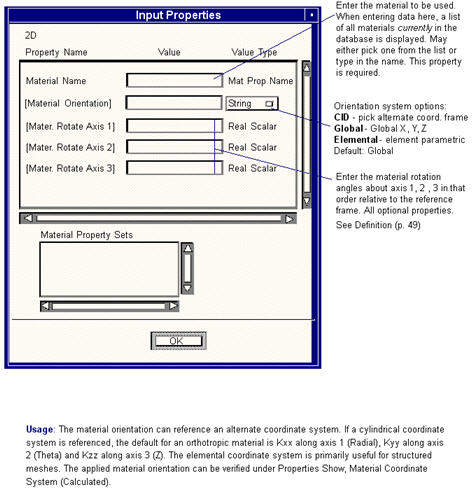
Analysis Type | Dimension | Type | Option(s) | Topologies |
Thermal | 2D | Thermal Axisymmetric | Full 360 Deg | Quad/4, Tri/3 |
Note: | This element property definition requires setting model dimensionality to axisymmetric geometry and selecting the radial and centerline axes under Analysis, Translation Parameters. |
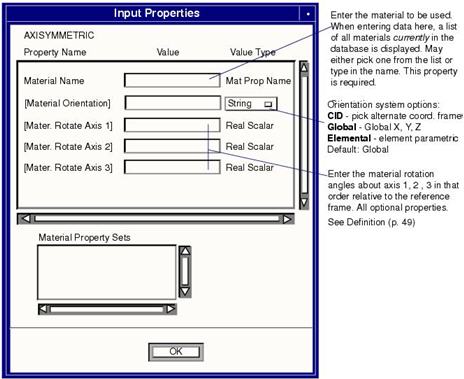
Analysis Type | Dimension | Type | Option(s) | Topologies |
Thermal | 2D | Thermal Axisymmetric | Specified Degs | Quad/4, Tri/3 |
Important: | This element property definition requires setting model dimensionality to axisymmetric geometry and selecting the radial and centerline axes under Analysis, Translation Parameters. The axisymmetric elements must lie on the plane and the 3D component must lie in the first quadrant. |
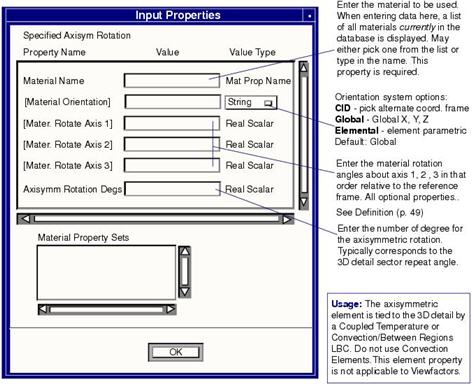
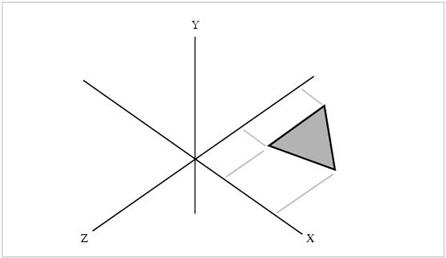
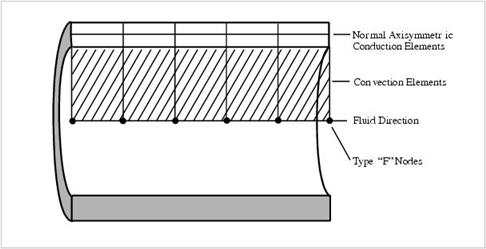
Analysis Type | Dimension | Type | Option(s) | Topologies |
Thermal | 2D | Convective Quad | Quad/4 |
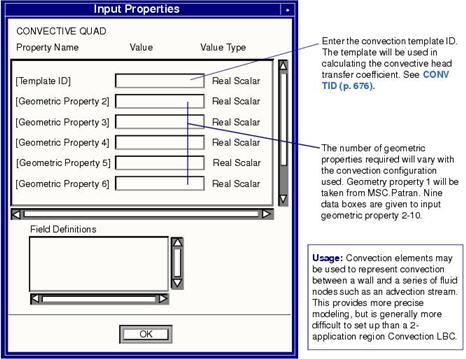
Analysis Type | Dimension | Type | Option(s) | Topologies |
Thermal | 3D | Thermal 3D Solid | FE hex,tet,wedge | Hex/8, Tet/4, Wedge/6 |
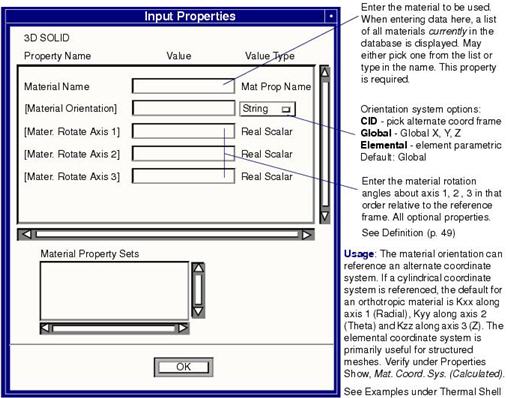
Analysis Type | Dimension | Type | Option(s) | Topologies |
Thermal | 3D | Thermal 3D Solid | Finite diff hex | Hex/8 |
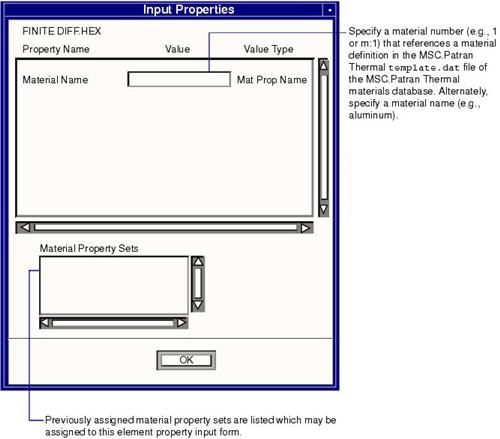
Note: | If a name is entered, the next available MID number will be assigned for use by Patran Thermal. |
Important: | Do not mix material names and MID references in the same model. |
Analysis Type | Dimension | Type | Option(s) | Topologies |
Thermal | 3D | Thermal 3D Solid | Scaled FE hex,tet,wedge | Hex/8, Tet/4, Wedge/6 |
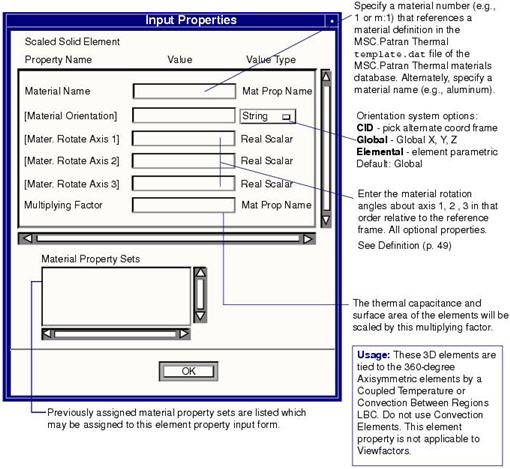
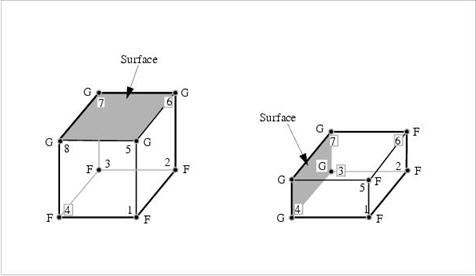
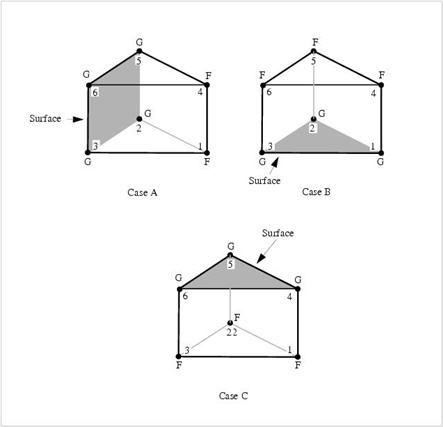
Analysis Type | Dimension | Type | Option(s) | Topologies |
Thermal | 3D | Convective Hex/Wedge | None | Hex/8, Wedge/6 |
